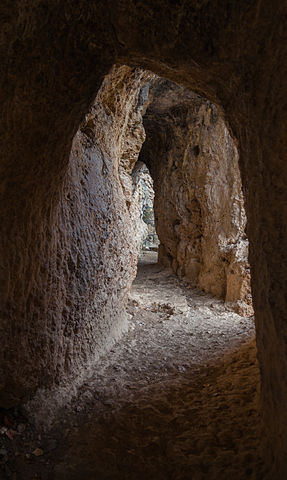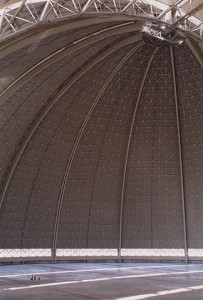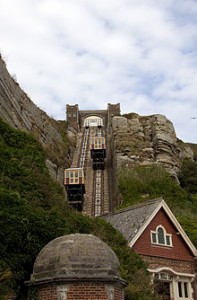When you think about the Roman Empire, one of the first things that pops into mind is their aqueduct system…unless you’ve been watching too much TV, in which case you’re likely thinking of their gladiators or legions.

Roman Aqueduct, c. 1st century, Spain
I feel pretty comfortable saying that the reason Rome was so stable for so long was due to their roads, aqueducts, sewer system, and other civil projects. It always grates me a little bit when people talk about the gladiatorial games being used to pacify the population—they certainly did that, but this was secondary to having clean water, plenty of food, and sanitation.
Thanks to the Roman Empire’s extensive civil improvements, Rome itself had a population of more than a MILLION people. That’s just nuts for a city in the ancient world. Athens maybe had 300K, and it was enormous for its time. There are only a few other ancient cities of comparable size at all.
That’s where Rome’s real success lay: not in conquest but in civil planning and construction. I know I’m starting to sound like a broken record in this blog space, going on about how people focused on war as the key part of history bugs me. (Maggie jokes sometimes that she is worried I’ll start buying Grateful Dead shirts and growing a ponytail.) It’s not about hating war, though. It’s about acknowledging that what we build and how we build it is, ultimately, the most important legacy of a society.
Eisenhower’s greatest accomplishment as President? The Interstate Highway System. What do we remember about the Egyptians? The pyramids. If you look at any society from more than a couple decades or so, what part of it lasts? Their construction.
The aqueducts have stood for millennia. I rest my case.
__________
Photo: Diego Delso, Wikimedia Commons, License CC-BY-SA 3.0

 Unfortunately, it sometimes isn’t possible to construct a shallow ramp, usually due to terrain. You’ve still got to be able to get up to the top, though, which is where funiculars come into the picture.
Unfortunately, it sometimes isn’t possible to construct a shallow ramp, usually due to terrain. You’ve still got to be able to get up to the top, though, which is where funiculars come into the picture. Depending on the amount of space available, the carts might have separate tracks, or they may share tracks. When they share track, there’s generally a split rail in the middle of the run that diverts the carts around each other.
Depending on the amount of space available, the carts might have separate tracks, or they may share tracks. When they share track, there’s generally a split rail in the middle of the run that diverts the carts around each other. The first use was actually pre-medieval, though it was used on occasion in medieval times. Siege ramps are huge earthen ramps built right up a castle or city wall, a cliff face, or other positions of strength. They’re about as absurd as you’d think: the builders are going to come under constant attack by the people above, resulting in a wasteful loss of life. It was really only used when the besiegers grossly outnumbered the besieged, were otherwise unable to break through the enemy defenses, and had little care for loss of life on their side. The Romans used it a few times, as did a few of the smaller empires before them, and a few of the smaller kingdoms they conquered.
The first use was actually pre-medieval, though it was used on occasion in medieval times. Siege ramps are huge earthen ramps built right up a castle or city wall, a cliff face, or other positions of strength. They’re about as absurd as you’d think: the builders are going to come under constant attack by the people above, resulting in a wasteful loss of life. It was really only used when the besiegers grossly outnumbered the besieged, were otherwise unable to break through the enemy defenses, and had little care for loss of life on their side. The Romans used it a few times, as did a few of the smaller empires before them, and a few of the smaller kingdoms they conquered. The other use was in siege towers. These, at least, were constructed with a bit more safety in mind for the troops on your side: not that sending them over an enemy castle wall is, particularly, a safer idea. Siege towers, depending on the whim of the builder, were generally a bizarre hybrid of ramp, staircase, ladder, and watchtower, all built out of wood and canvas and stuck on wheels to roll right up to the castle walls, where troops could exit the tower directly onto those walls.
The other use was in siege towers. These, at least, were constructed with a bit more safety in mind for the troops on your side: not that sending them over an enemy castle wall is, particularly, a safer idea. Siege towers, depending on the whim of the builder, were generally a bizarre hybrid of ramp, staircase, ladder, and watchtower, all built out of wood and canvas and stuck on wheels to roll right up to the castle walls, where troops could exit the tower directly onto those walls. The ancient Greeks recognized three simple machines to start with: the lever, the screw, and the pulley. The man who came up with the idea, Archimedes, was a brilliant but crazy guy. Built crazy ancient super weapons to sink entire enemy fleets one day, then jury rigged an ancient precursor to calculus the next. He’s considered one of the greatest mathematicians of all time for a good reason. He’s the kind of dude who could have moved the world, if you gave him a long-enough lever.
The ancient Greeks recognized three simple machines to start with: the lever, the screw, and the pulley. The man who came up with the idea, Archimedes, was a brilliant but crazy guy. Built crazy ancient super weapons to sink entire enemy fleets one day, then jury rigged an ancient precursor to calculus the next. He’s considered one of the greatest mathematicians of all time for a good reason. He’s the kind of dude who could have moved the world, if you gave him a long-enough lever. After Simon Steven completed the simple machine sextet, of course, the development of the science behind simple machines hardly stopped. Galileo Galilei, notably, was the first to figure out that they didn’t create energy but merely transformed it. Leonardo da Vinci also made some critical discoveries regarding calculating friction in simple machines; then he promptly left them unpublished in his notebooks. It took almost two hundred years for someone else to independently rediscover them.
After Simon Steven completed the simple machine sextet, of course, the development of the science behind simple machines hardly stopped. Galileo Galilei, notably, was the first to figure out that they didn’t create energy but merely transformed it. Leonardo da Vinci also made some critical discoveries regarding calculating friction in simple machines; then he promptly left them unpublished in his notebooks. It took almost two hundred years for someone else to independently rediscover them.